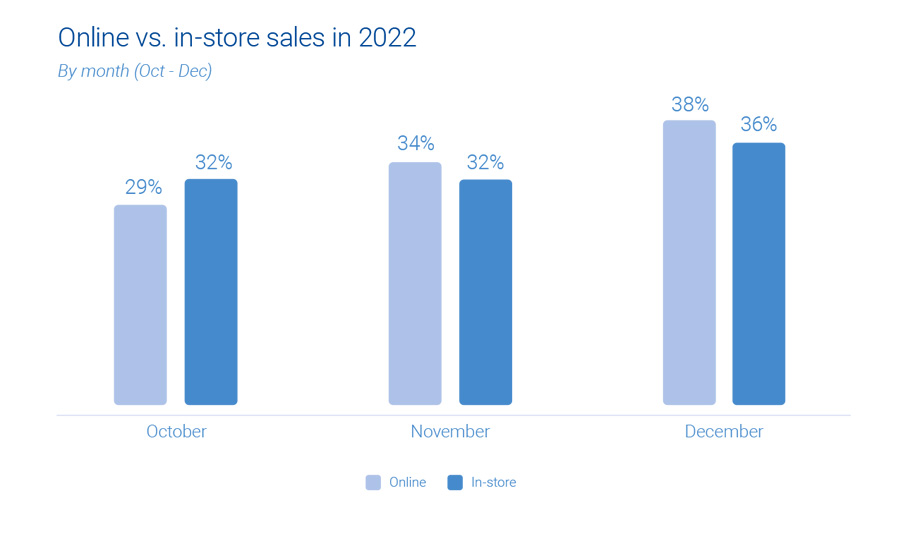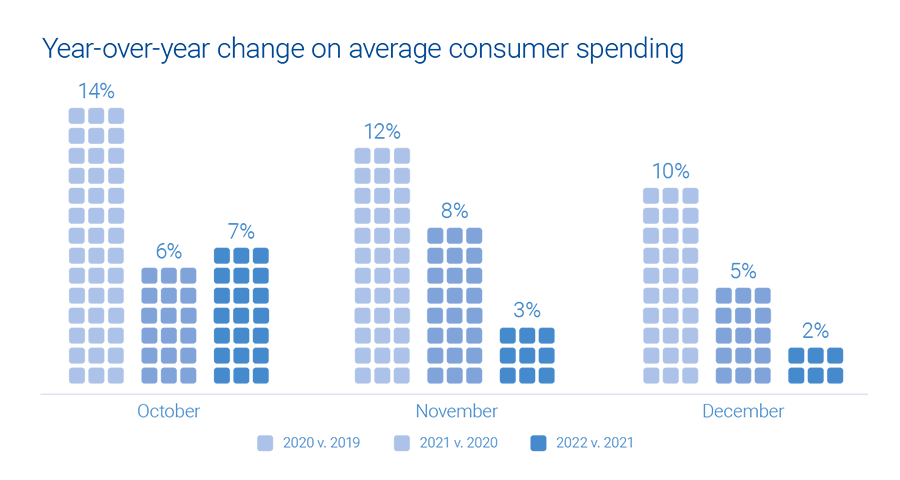
The holiday season is just around the corner, and retailers and marketers are gearing up for the busiest shopping period of the year. It’s crucial to understand how consumer behavior is evolving and what emerging trends to expect. Experian’s 2023 Holiday spending trends and insights report analyzes recent trends, consumer spending habits, and anticipates what’s to come in 2023 to help you deliver a top-notch shopping experience this holiday season.
In this blog post, we’ll cover three key insights from our report.
1. Consumers are shopping earlier
It’s no secret that December has always been the go-to month for consumers when it comes to holiday spending. However, holiday shopping now starts earlier, particularly with online sales.

This can be attributed to a surge in promotions and deals, enticing shoppers to open their wallets ahead of time, giving a significant boost to holiday sales. Notably, Cyber Week sales have proven to be an influential factor, accounting for 8% of total consumer holiday spending.
Experian tip
Reach the right shoppers with your promotions with sell-side targeting. This powerful approach gives you control over where your ads are placed while ensuring maximum visibility through direct connections with publishers. Whether on mobile, web, or CTV, this seamless ad experience will engage your audience effectively.
2. Online sales are on the rise
The popularity of online holiday sales is continuously growing, surpassing in-store shopping. There has been a consistent 1% year-over-year increase in online sales, while in-store sales have seen a 1% decrease.
“It’s easier for consumers to comparison shop for large ticket items online that they might find at a mass retailer or office supply store. Consumers prefer to have larger, bulkier items shipped directly to their home for minimal cost. By shopping online, consumers can save time since they don’t need to wait in checkout lines.”
Anna Liparoto, Sr. Account Executive, Retail & CPG

Although online sales currently make up only one-third of all holiday shopping, there is immense potential for further expansion. Mass retailers and office, electronics, and games industries particularly excel in online holiday sales. While in-store purchases remain the primary choice for holiday shoppers, consumer online and offline activities intersect before the final purchase.
Experian tip
Take advantage of the surge in online shopping by diversifying your marketing channels. An agnostic identity graph can bring together device and media data, capturing valuable user insights. By gaining a holistic view of your target audience, you’ll be able to optimize your ad spend and allocate resources effectively, ultimately boosting your return on investment.
“Omnichannel targeting during the upcoming holiday season will continue to prove to be the best way to reach scale and maximize ROI across all marketing channels.”
Joe Ligé, Head of Enterprise Demand Partnerships
3. 2023 holiday spending will be on par with 2022
During the holiday season in 2022, consumer spending showed an anticipated increase, although the growth rate was slightly lower compared to previous years. October saw a surge in average consumer spending, indicating a swift response to early discounts and promotions offered by retailers.

As the holiday season progressed, holiday spending gradually slowed down and reached a level similar to that of the previous year. Overall, there was a modest 2% growth. Looking into the future, if economic conditions remain stable in the second half of 2023, we can expect holiday spending to align with the figures from last year.
Experian tip
To truly maximize impact, consider data enrichment. By diving deeper into your target audience’s preferences and behaviors, you can better tailor your strategies and seamlessly integrate the enriched data across various channels. This allows you to unlock the true potential of your ad inventory, creating more meaningful connections with your audience.
Download our new 2025 report
Get ready for the holiday shopping season with Experian’s 2025 Holiday spending trends and insights report, in collaboration with GroundTruth. Inside you’ll find:
- When shoppers plan to buy
- Why stores still drive results
- Where marketers are placing their bets
- How AI is shaping discovery
To access to all of our predictions for this year’s holiday shopping season, download our 2025 Holiday spending trends and insights report today.
Contact us today
Latest posts

Partnership leverages industry-leading Tapad Device Graph™ for more effective video marketing across all connected devices NEW YORK, April 11, 2017 /PRNewswire/ – Tapad, a part of Experian, the leading provider of privacy-safe, cross-device marketing technology solutions, has announced its partnership with Innovid, the world's leading video marketing platform. This integration enables Innovid to bring cross-device personalization and a more unified viewer experience to its video marketing clients including Bank of America, L'Oréal, Microsoft and Procter & Gamble. Innovid's proprietary technology is the only platform optimized for video, enabling marketers to thrive in an ever-changing digital television landscape. Since its launch last year, Innovid's Marketing Cloud Suite has helped marketers increase message relevance and the opportunity to drive conversions, retention and acquisition through video personalization. By leveraging the Tapad Device GraphTM, Innovid's marketers can now benefit from the ability to drive consistent, personalized user experiences across all devices, creating more impactful connections with consumers and increasing ROI. "Personalization is a must for every data-driven marketer and really needs to happen across all devices to ensure a unified customer journey," says Ronnie Lavi, SVP of product at Innovid. "At Innovid, we recognize one size does not fit all when it comes to video. As an open platform, we are always looking to add best-of-breed capabilities through integrations and partnerships, and we've chosen Tapad because of its superior cross-device expertise." "Innovid has long paved the way for effective personalization in the video marketing space," says Pierre Martensson, GM of Tapad's data division. "As video continues to gain popularity across digital formats, we're excited to see how our technology empowers Innovid to bring that renowned personalization to more customers across all of their devices." Contact us today

Tracey Scheppach's new marketing and media practice leverages Tapad's device-level data to help clients achieve "marketing nirvana" NEW YORK and CHICAGO, April 5, 2017 /PRNewswire/ — Today, Tapad, now part of Experian, is the leading provider of unified, cross-screen marketing technology solutions, and Matter More, a next generation marketing and media practice with deep experience in the advanced TV space, announced a strategic partnership to bring together world class digital data and audience development expertise to help marketers improve how they connect with consumers. As consumer behavior continues to expand across multiple devices, today's marketers need robust, comprehensive data solutions to accurately engage the people who matter most to their brands. At the same time, the TV industry has reached an advertising tipping point, capitalizing on the power of device-level data. "Achieving unduplicated reach and frequency across all channels with true addressability, and the ability to measure outcomes, is marketing nirvana," says Tracey Scheppach, CEO and co-founder of Matter More, a new agency built for the modern age. "The best opportunity to deliver 'marketing nirvana,' at scale, is by partnering with Tapad and using their world-class Device Graph to help our clients simply matter more to the people they care about most." "By leveraging our access to rich TV data, we can now measure the actual performance of media across channels," says Marshall Wong, SVP, TV for Tapad. Tapad's proprietary Device Graph™ unifies consumer behavior data across all devices, uncovering the interests, passions and behaviors of the audiences who matter most. As with any data solution, privacy, transparency and trust are crucial to bringing marketers a solid offering that delivers results. "Tapad is excited to partner with Matter More to tap into their knowledge base and experience working with some of the largest brands on TV today," says Kate O'Loughlin, SVP and GM of Tapad's media division. "The time has come to truly unleash the power of device-level data at scale." Contact us today

Globalization affects retailers in a number of ways. Complying with commercial laws wherever they have brick-and-mortar stores is one such impact. Navigating through privacy rules that impact e-commerce efforts is another. There is one blind spot in particular that deserves attention — sending shopping cart abandonment emails. I am often asked, “How are abandonment emails treated under the CAN-SPAM Act? Canada’s stringent Anti-Spam Law (CASL)?” “Can I even send abandonment emails to my Canadian customers?” What are cart abandonment emails? But let’s back up… What is an ‘abandonment’ email anyway? In the email space shopping cart abandonment refers to a particular type of automated mailing used to re-engage an online customer. The most common example is one where a retailer notices that a customer has left an item sitting in their shopping cart, and proceeds to send a reminder with a coupon to complete the order. To fully understand privacy compliance pitfalls with this technique, in the U.S. and beyond, we need to unpack what happens before the abandonment email is sent. Email marketing shopping cart abandonment compliance Abandonment messages are almost always ‘commercial’, particularly if they incentivize a shopper to complete their purchase. In compliance parlance, we call this encouraging the continuation of a commercial activity. In contrast, an order confirmation typically provides factual information about a commercial activity. Under most anti-spam laws, particularly under CASL, marketers need to ensure abandonment messages are not unsolicited. Triggering should account for: Appropriate consent covering email marketing to new or ongoing online relationships. Scrubbing the customer’s email address against your unsubscribe/suppression lists before sending a solicitous message. (This is true under any anti-spam law.) For more information about CASL-compliant consent record keeping and related best practices, you can navigate to the Canadian Radio-television and Telecommunications Commission. Maintaining compliance with online tracking Abandonment emails rely on online retailers tracking their customers’ activity on their websites and tying online behavior back to the email addresses using the same behavioral targeting technologies as those used to deliver Interest Based Ads. This jump across engagement channels to remarket to customers can raise privacy concerns, so online retailers need to pay attention to their privacy compliance obligations. Cross-channel marketing privacy protections Guidance covering privacy policies and practices issued by the Federal Trade Commission are informative and I encourage you to review these with your law department. If you operate outside the U.S., privacy protection laws like Canada’s Personal Information Protection and Electronic Documents Act (PIPEDA) may set out additional obligations with your cross-channel marketing efforts. PIPEDA’s definition of commercial activity, which includes remarketing Privacy Commissioner’s findings under PIPEDA in relation to remarketing Privacy Commissioner’s guidance on online behavioral advertising, the technology of which informs triggered emails Under PIPEDA and similar international privacy regimes, cross-channel marketers will need to (i) clearly and conspicuous inform website visitors that their online activities may result in personalized marketing, (ii) offer a way to opt-out of such tracking, and (iii) obtain individuals’ prior express consent with tracking involving sensitive personal information such as health data How to manage cross-channel marketing compliance risks As privacy protection regimes around the world continue to mature and absorb rules covering marketing, online retailers need to start adding new vocabulary to their privacy compliance lexicon. For example, shopping cart abandonment efforts produce ‘cross-channel re-marketing campaigns triggered by an identifiable individual’s online behavior.’ While this is a mouthful to say, viewing your engagement efforts through this lens will help you manage compliance risks. Experian can help you navigate compliance risks Our privacy-first approach to data is trusted across industries around the world. As a leader in the industry, we are here to help you leverage the power of data while maintaining the highest standards of consumer privacy compliance and legal guidelines. With almost 30 years in business, we are here to help you confidently create and launch data-driven marketing strategies. Contact us today to get started! Please note: Cross-Channel Marketing does not give legal advice on electronic marketing regulations or privacy laws. To mitigate risk to your business, please consult with your legal counsel on the law and your corporate policy. Contact us today